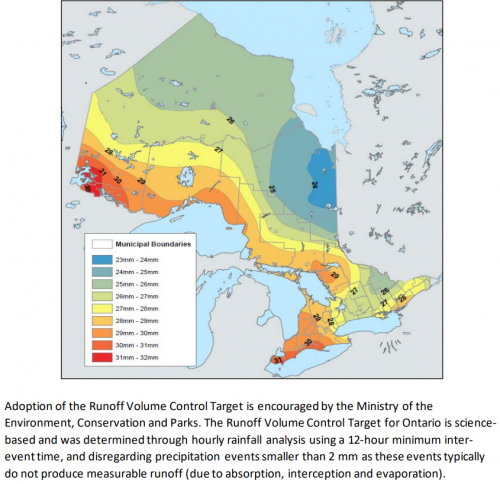Runoff volume control targets

Typically designed to handle the smaller, most frequent storm events, LID practices in Ontario are usually sized according to the 90th percentile event. The rainfall depth of the 90th percentile event varies geographically. Use the map on the right to determine the typical 90th percentile event based on the site location. Controlling this amount of runoff may provide stormwater engineers with control of over 90 % of the mean annual pollutant load [2].
See Understanding rainfall statistics to learn how to calculate the 90th percentile event using rainfall observations for a specific site.
See Climate change to learn about adjusting runoff volume control targets to account for future precipitation trends.
Runoff Volume Control Target (RVCT)[edit]
"The means to achieve the RVCT includes:
Retention - where the captured volume shall be ultimately infiltrated, evapotranspired or re-used and the specified volume will not later be discharged to sewer networks (with the exception of internal water re-use activities) or surface waters and does not therefore become runoff, and
Volume capture and treatment - Also referred to as `treatment and release`, where the volume capture and treatment directly aims at reducing surface water impairment through treatment of the specified volume, often referred to as a “water quality volume”.[3]
- ↑ MECP. 2022. Low Impact Development Stormwater Management Guidance Manual Draft. https://ero.ontario.ca/public/2022-01/Draft%20LID%20Stormwater%20Management%20Guidance%20Manual%202022.pdf
- ↑ Pitt, R. 1999. Small Storm Hydrology and Why it is Important for the Design of Stormwater Control Practices. In: Advances in Modeling the Management of Stormwater Impacts, Volume 7. Computational Hydraulics International, Guelph, Ontario and Lewis Publishers/CRC Press. 1999
- ↑ MOECC (2018)